Influence of Ramped Compression on the Dielectric Behavior of the High-Voltage Epoxy Composites
Abstract
:1. Introduction
Preparation of Nanocomposite
2. Measurements and Methods
2.1. Dielectric Properties Measurement
2.2. Compression Setup and Conditions
3. Results and Discussion
3.1. Results at Low Frequency
3.2. Analysis in the Range of 60 kHz–2 MHz
3.3. Ramped Compression Effects
4. Conclusions
Author Contributions
Funding
Institutional Review Board Statement
Informed Consent Statement
Data Availability Statement
Acknowledgments
Conflicts of Interest
References
- Gubanski, S.; Vlastos, A. Wettability of naturally aged silicon and EPDM composite insulators. IEEE Trans. Power Deliv. 1990, 5, 1527–1535. [Google Scholar] [CrossRef]
- Kornbluh, R.D.; Pelrine, R.; Joseph, J.; Heydt, R.; Pei, Q.; Chiba, S. High-field electrostriction of elastomeric polymer dielectrics for actuation. Symp. Smart Struct. Mater. 1999, 3669, 149–161. [Google Scholar] [CrossRef]
- Du, B.X.; Li, A.; Li, J. Effects of AC and pulse voltage combination on surface charge accumulation and decay of epoxy resin. IEEE Trans. Dielectr. Electr. Insul. 2016, 23, 2368–2376. [Google Scholar] [CrossRef]
- Haque, S.; Ardila-Rey, J.; Umar, Y.; Mas’Ud, A.; Muhammad-Sukki, F.; Jume, B.; Rahman, H.; Bani, N. Application and Suitability of Polymeric Materials as Insulators in Electrical Equipment. Energies 2021, 14, 2758. [Google Scholar] [CrossRef]
- Du, B.X.; Xu, H.; Li, J. Effects of mechanical stretching on space charge behaviors of PP/POE blend for HVDC cables. IEEE Trans. Dielectr. Electr. Insul. 2017, 24, 1438–1445. [Google Scholar] [CrossRef]
- Da Silva, R.F.; Swinka Filho, V. Analysis of electrical tracking by energy absorption during surface discharge in polymeric materials. IEEE Trans. Dielectr. Electr. Insul. 2016, 23, 501–506. [Google Scholar] [CrossRef]
- Shen, J.T.; Buschhorn, S.T.; De Hosson, J.T.M.; Schulte, K.; Fiedler, B. Pressure and temperature induced elec-trical resistance change in nano-carbon/epoxy composites. Compos. Sci. Technol. 2015, 115, 1–8. [Google Scholar] [CrossRef]
- Khattak, A.; Imran, K.; Ali, A.; Khan, Z.S.; Ulasyar, A.; Amin, M.; Khan, A.; Haq, A.U. Effects of Compression and Silica Addition on the Dielectric Properties of Epoxy Composites. Arab. J. Sci. Eng. 2020, 45, 6741–6750. [Google Scholar] [CrossRef]
- Shen, W.; Ou, T.; Wang, J.; Qin, T.; Zhang, G.; Zhang, X.; Han, Y.; Ma, Y.; Gao, C. Effects of high pressure on the electrical re-sistivity and dielectric properties of nanocrystalline SnO2. Sci. Rep. 2018, 8, 5086. [Google Scholar] [CrossRef] [Green Version]
- Du, B.X.; Su, J.G.; Li, J.; Han, T. Effects of mechanical stress on treeing growth characteristics in HTV silicone rubber. IEEE Trans. Dielectr. Electr. Insul. 2017, 24, 1547–1556. [Google Scholar] [CrossRef]
- Girão, H.T.; Cornier, T.; Daniele, S.; Debord, R.; Caravaca, M.A.; Casali, R.A.; Mélinon, P.; Machon, D. Pressure-Induced Disordering in SnO2 Nanoparticles. J. Phys. Chem. C 2017, 121, 15463–15471. [Google Scholar] [CrossRef]
- Cheng, K.-C.; Lin, C.-M.; Wang, S.-F.; Lin, S.-T.; Yang, C.-F. Dielectric properties of epoxy resin–barium titanate composites at high frequency. Mater. Lett. 2007, 61, 757–760. [Google Scholar] [CrossRef]
- Pierson, H.A.; Celik, E.; Abbott, A.; De Jarnette, H.; Gutierrez, L.S.; Johnson, K.; Koerner, H.; Baur, J.W. Mechanical Properties of Printed Epoxy-Carbon Fiber Composites. Exp. Mech. 2019, 59, 843–857. [Google Scholar] [CrossRef]
- Jaafar, C.A.; Zainol, I.; Ishak, N.S.; Ilyas, R.A.; Sapuan, S.M. Effects of the liquid natural rubber (LNR) on mechanical properties and microstructure of epoxy/silica/kenaf hybrid composite for potential automotive applications. J. Mater. Res. Technol. 2021, 12, 1026–1038. [Google Scholar] [CrossRef]
- Bazli, L.; Eskandarinezhad, S.; Kakur, N.; Ramachandran, V.; Bacigalupe, A.; Mansilla, M.; Escobar, M. Electrical properties of polymer blend composites based on Silicone rubber/EPDM/clay for high voltage insulators. J. Compos. Compd. 2020, 2, 18–24. [Google Scholar] [CrossRef]
- Preetha, P.; Thomas, M.J. AC breakdown characteristics of epoxy nanocomposites. IEEE Trans. Dielectr. Electr. Insul. 2011, 18, 1526–1534. [Google Scholar] [CrossRef]
- Wang, R.; Xie, C.; Zeng, L.; Xu, H. Thermal decomposition behavior and kinetics of nanocomposites at low-modified ZnO content. RSC Adv. 2019, 9, 790–800. [Google Scholar] [CrossRef] [Green Version]
- Venkatesulu, B. Studies on Polymeric Micro/Nanocomposites for Outdoor High Voltage Insulation. Ph.D. Thesis, Indian Institute of Science, Bangalore, India, 2011. [Google Scholar]
- Nelson, J.; Utracki, L.; MacCrone, R.; Reed, C. Role of the interface in determining the dielectric properties of nanocomposites. In Proceedings of the 17th Annual Meeting of the IEEE Lasers and Electro-Optics Society, LEOS 2004, Boulder, CO, USA, 20–22 October 2004. [Google Scholar] [CrossRef] [Green Version]
- Ramirez Vazquez, I. A Study of Nanofilled Silicone Dielectrics for Outdoor Insulation. Ph.D. Thesis, University of Waterloo, Waterloo, ON, Canada, 2009. [Google Scholar]
- Amin, M.; Ali, M. Polymer nanocomposites for high voltage outdoor insulation applications. Rev. Adv. Mater. Sci. 2015, 40, 276–294. [Google Scholar]
- Fairus, M.; Mansor, N.S.; Hafiz, M.; Kamarol, M.; Mariatti, M. Investigation on dielectric strength of alumina nanofiller with SiR/EPDM composites for HV insulator. In Proceedings of the 2015 IEEE 11th International Conference on the Properties and Applications of Dielectric Materials (ICPADM), Sydney, Australia, 19–22 July 2015; pp. 923–926. [Google Scholar]
- Singha, S.; Thomas, M.J. Dielectric properties of epoxy nanocomposites. IEEE Trans. Dielectr. Electr. Insul. 2008, 15, 12–23. [Google Scholar] [CrossRef]
- Yim, M.J.; Kwon, W.; Paik, K.W. Effect of filler content on the dielectric properties of anisotropic conductive adhesives materials for high-frequency flip–chip interconnection. Mater. Sci. Eng. B 2006, 126, 59–65. [Google Scholar] [CrossRef]
- Foo, E.; Jaafar, M.; Aziz, A.; Sim, L.C. Properties of spin coated epoxy/silica thin film composites: Effect of nano- and micron-size fillers. Compos. Part A Appl. Sci. Manuf. 2011, 42, 1432–1437. [Google Scholar] [CrossRef]
- Momen, G.; Farzaneh, M. Survey of micro/nano filler use to improve silicone rubber for outdoor insulators. Rev. Adv. Mater. Sci. 2011, 27, 1–13. [Google Scholar]
- Guevara-Morales, A.; Taylor, A.C. Mechanical and dielectric properties of epoxy–clay nanocomposites. J. Mater. Sci. 2013, 49, 1574–1584. [Google Scholar] [CrossRef]
- Tanaka, T. Dielectric nanocomposites with insulating properties. IEEE Trans. Dielectr. Electr. Insul. 2005, 12, 914–928. [Google Scholar] [CrossRef]
- Yu, J.; Huo, R.; Wu, C.; Wu, X.; Wang, G.; Jiang, P. Influence of interface structure on dielectric properties of epoxy/alumina nanocomposites. Macromol. Res. 2012, 20, 816–826. [Google Scholar] [CrossRef]


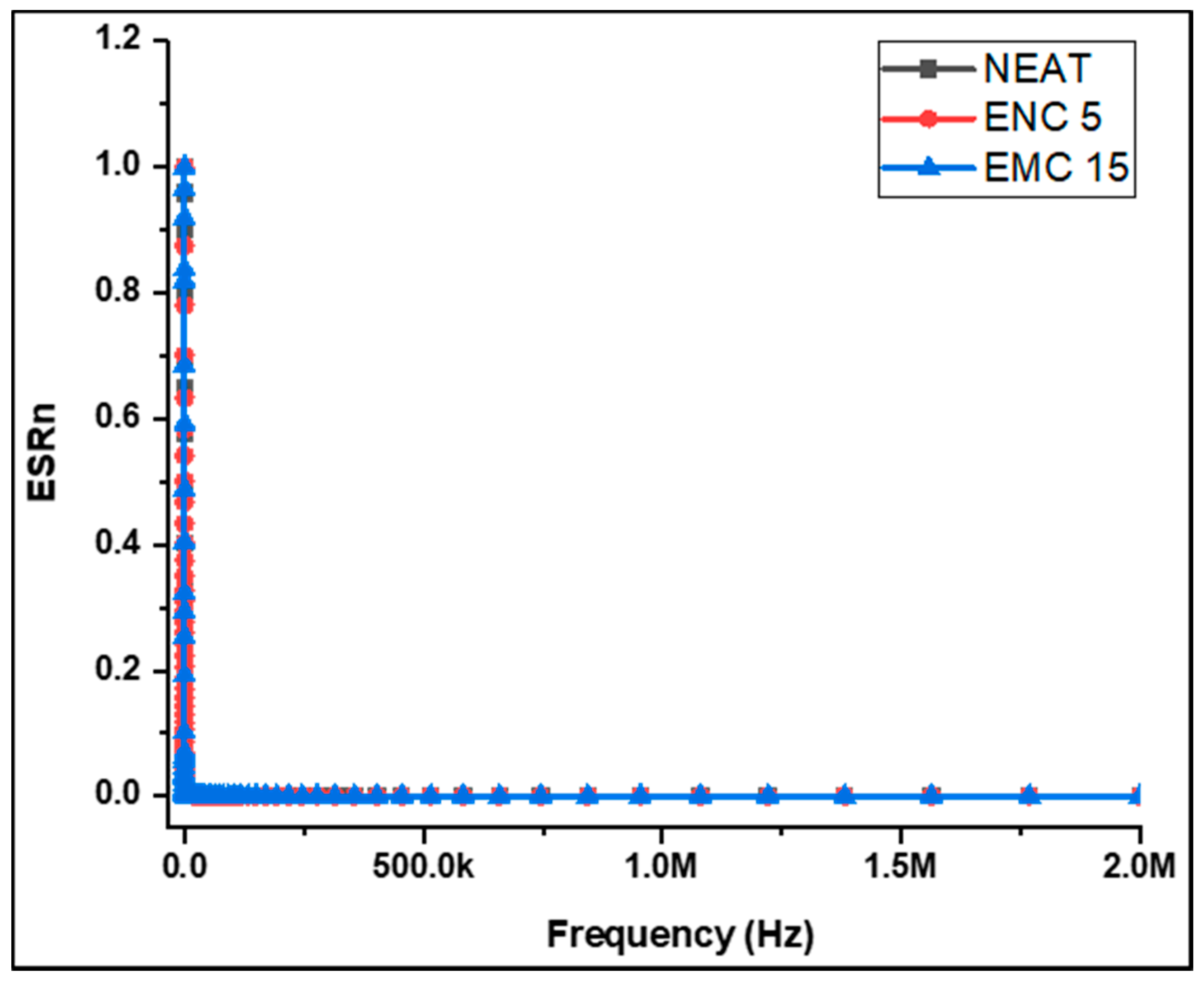


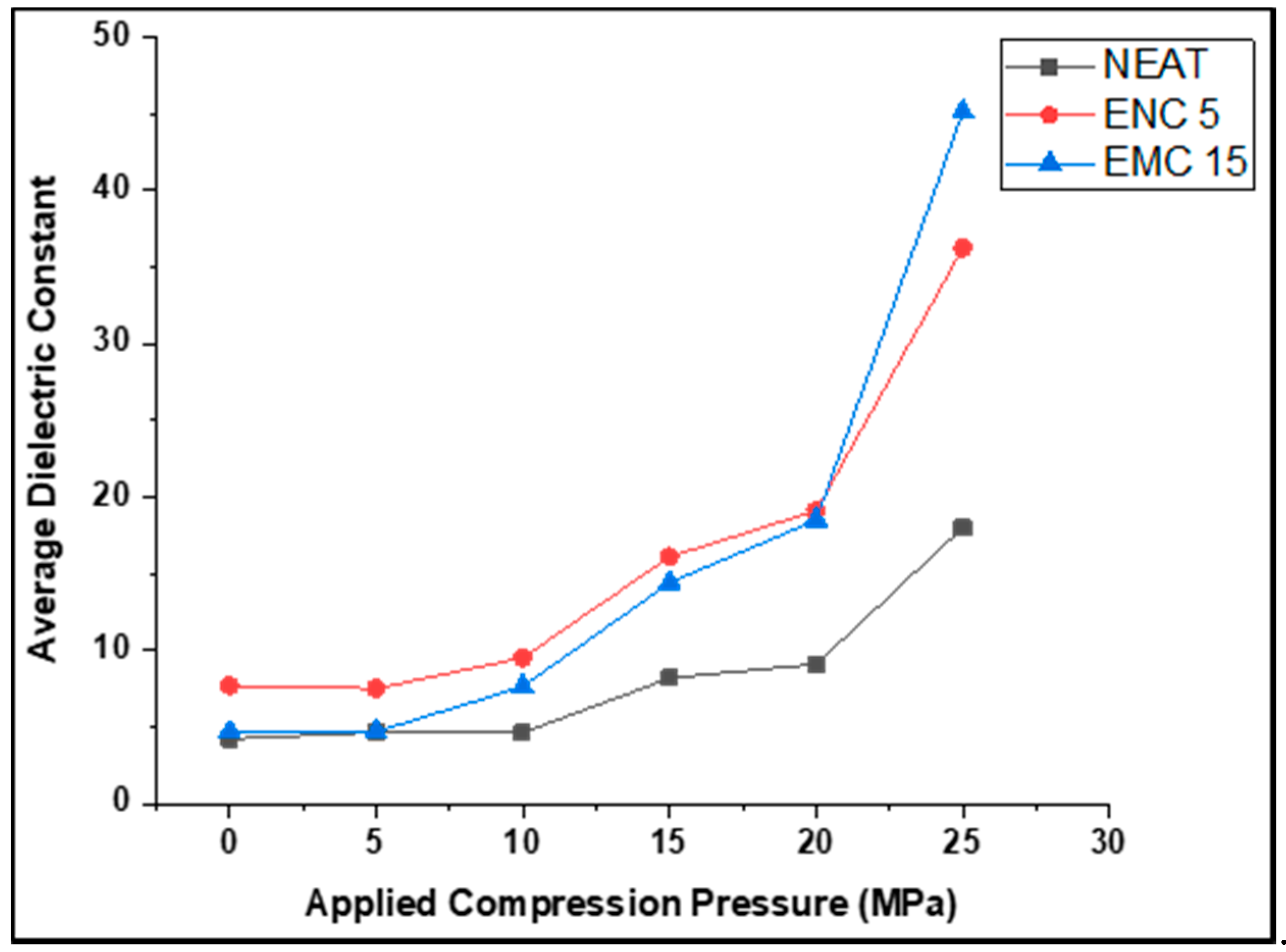
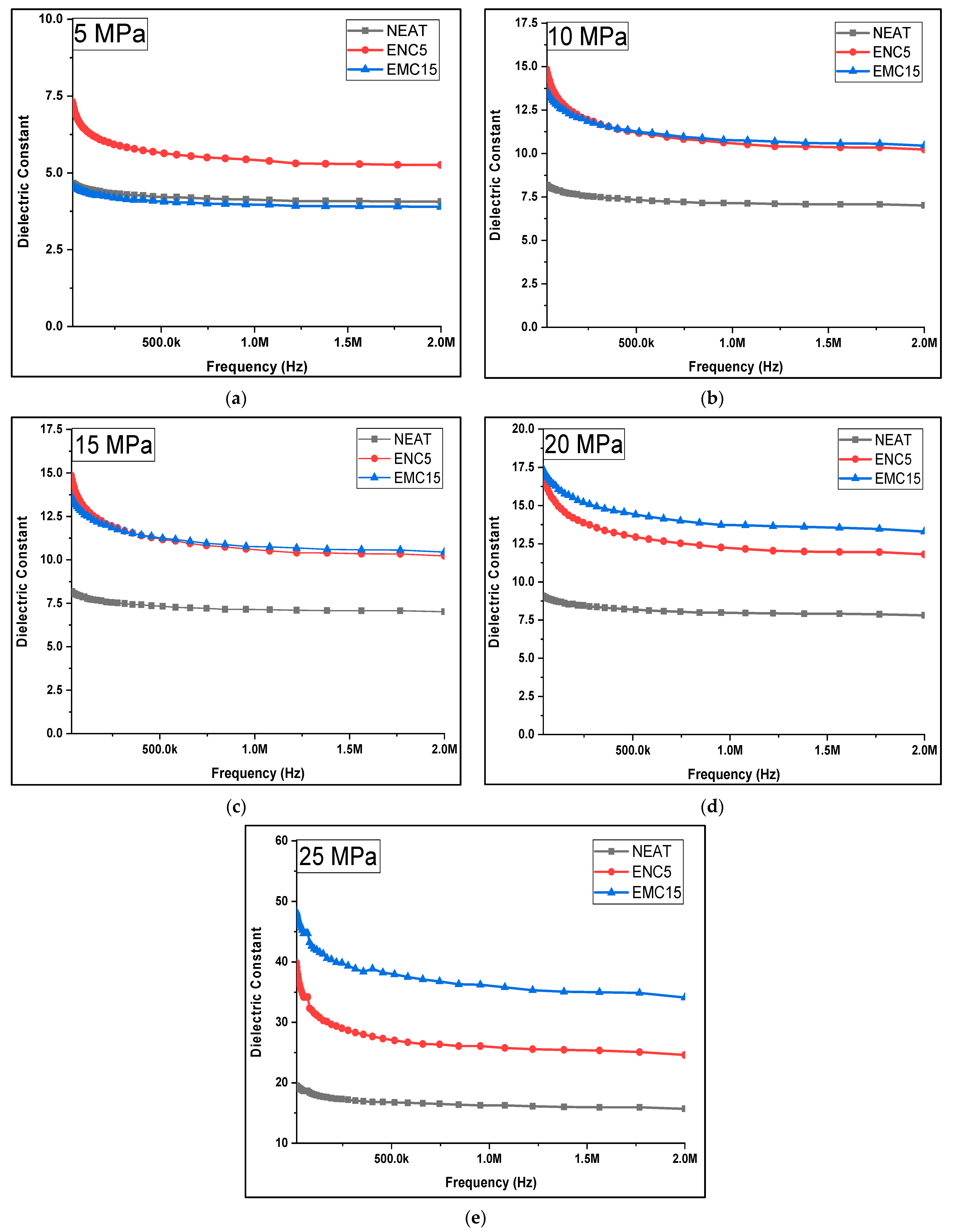

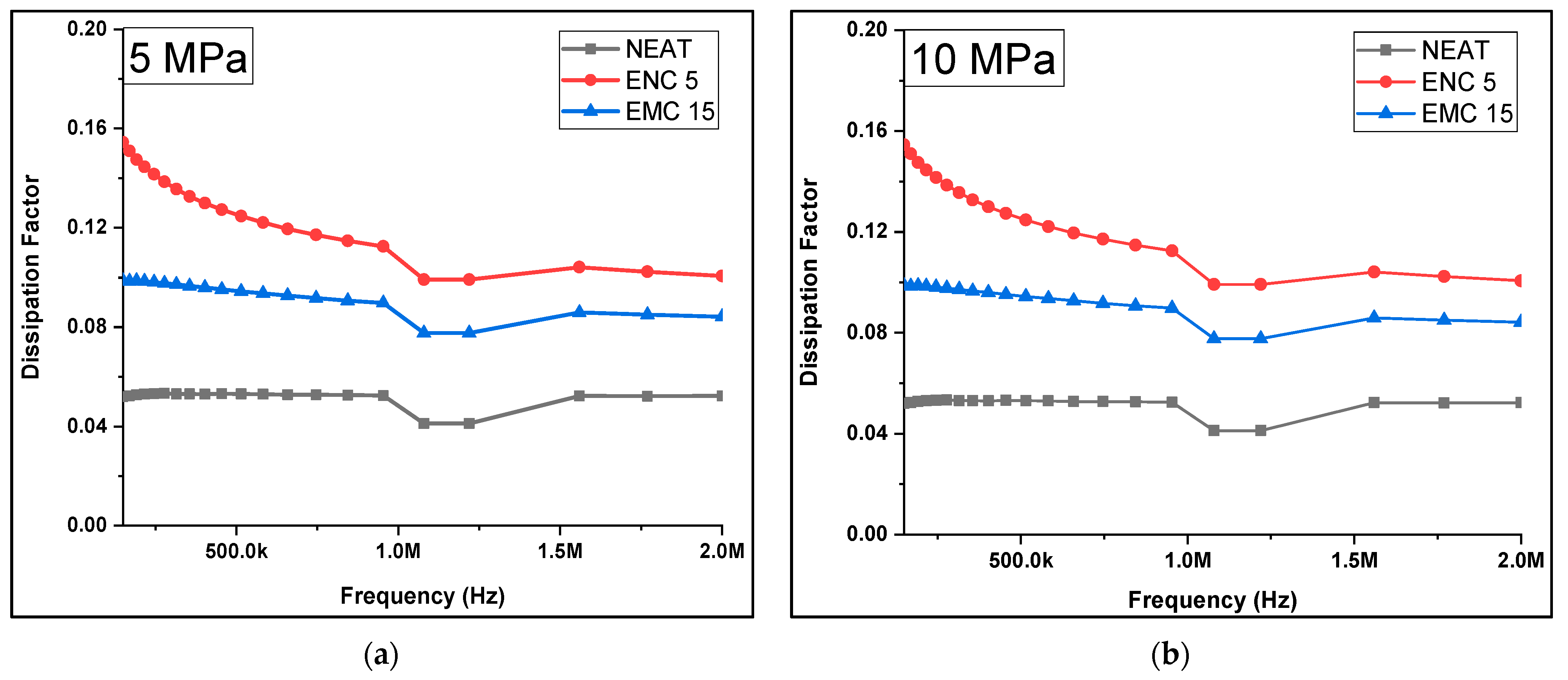
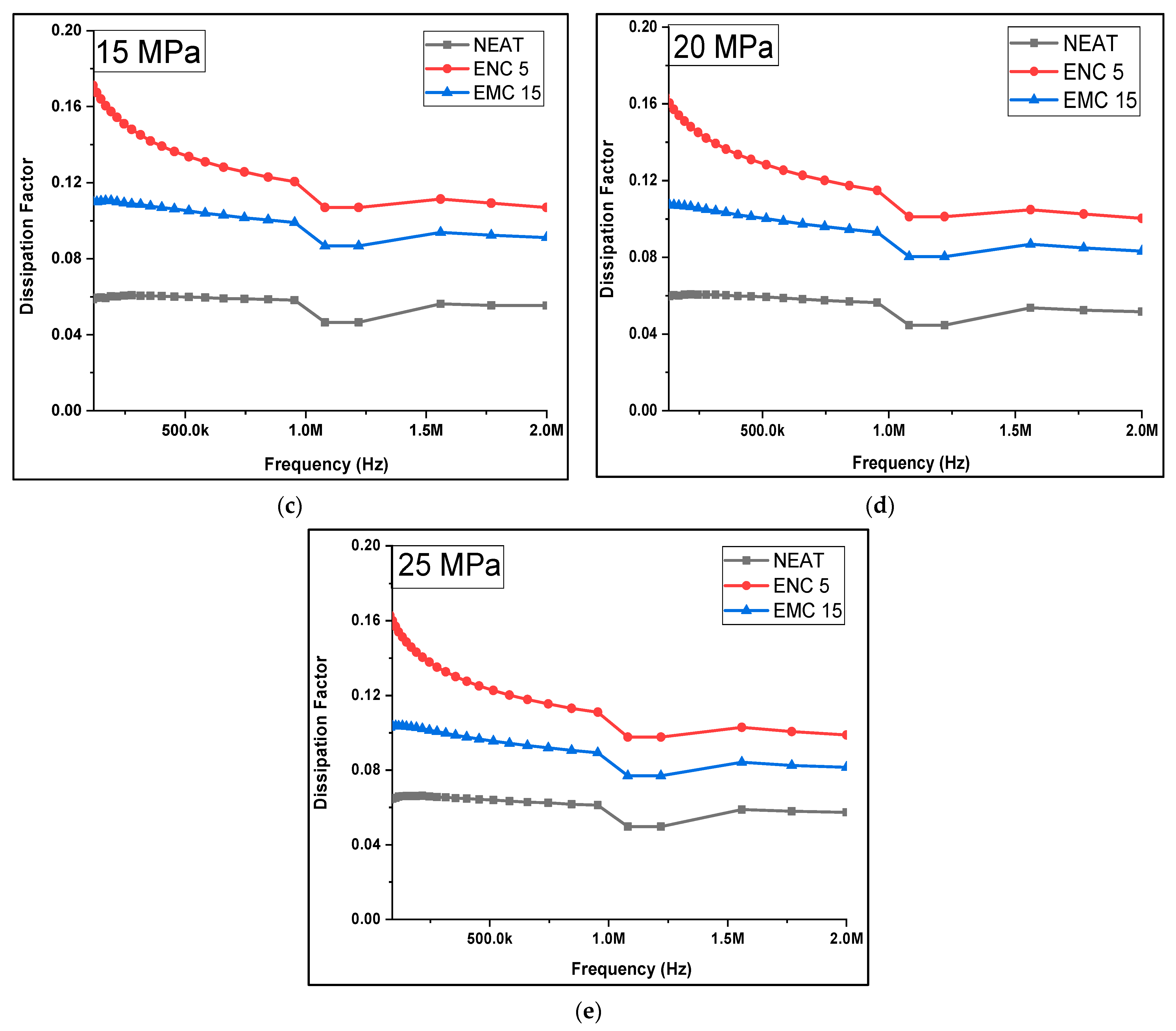
| Sample | Code |
|---|---|
| Neat Epoxy | Neat |
| Epoxy—with 5 wt.% Nano-silica Filler | ENC 5 |
| Epoxy—with 15 wt.% Micro-silica Filler | EMC 15 |
| Samples | 0 MPa | 5 MPa | 10 MPa | 15 MPa | 20 MPa | 25 MPa |
|---|---|---|---|---|---|---|
| NEAT | 4.22 | 4.63 | 4.61 | 8.18 | 9.08 | 18.01 |
| ENC 5 | 7.68 | 7.50 | 9.51 | 16.10 | 19.10 | 36.24 |
| EMC 15 | 4.68 | 4.67 | 7.65 | 14.41 | 18.52 | 45.14 |
| Samples | 0 MPa | 5 MPa | 10 MPa | 15 MPa | 20 MPa | 25 MPa |
|---|---|---|---|---|---|---|
| NEAT | 0.03 | 0.03 | 0.03 | 0.04 | 0.04 | 0.04 |
| EMC 15 | 0.05 | 0.06 | 0.09 | 0.10 | 0.10 | 0.11 |
| ENC 5 | 0.18 | 0.18 | 0.24 | 0.25 | 0.24 | 0.26 |
Publisher’s Note: MDPI stays neutral with regard to jurisdictional claims in published maps and institutional affiliations. |
© 2021 by the authors. Licensee MDPI, Basel, Switzerland. This article is an open access article distributed under the terms and conditions of the Creative Commons Attribution (CC BY) license (https://creativecommons.org/licenses/by/4.0/).
Share and Cite
Iqbal, M.B.; Khattak, A.; Ali, A.; Raza, M.H.; Ullah, N.; Alahmadi, A.A.; Khan, A. Influence of Ramped Compression on the Dielectric Behavior of the High-Voltage Epoxy Composites. Polymers 2021, 13, 3150. https://doi.org/10.3390/polym13183150
Iqbal MB, Khattak A, Ali A, Raza MH, Ullah N, Alahmadi AA, Khan A. Influence of Ramped Compression on the Dielectric Behavior of the High-Voltage Epoxy Composites. Polymers. 2021; 13(18):3150. https://doi.org/10.3390/polym13183150
Chicago/Turabian StyleIqbal, Muhammad Bilal, Abraiz Khattak, Asghar Ali, M. Hassan Raza, Nasim Ullah, Ahmad Aziz Alahmadi, and Adam Khan. 2021. "Influence of Ramped Compression on the Dielectric Behavior of the High-Voltage Epoxy Composites" Polymers 13, no. 18: 3150. https://doi.org/10.3390/polym13183150






